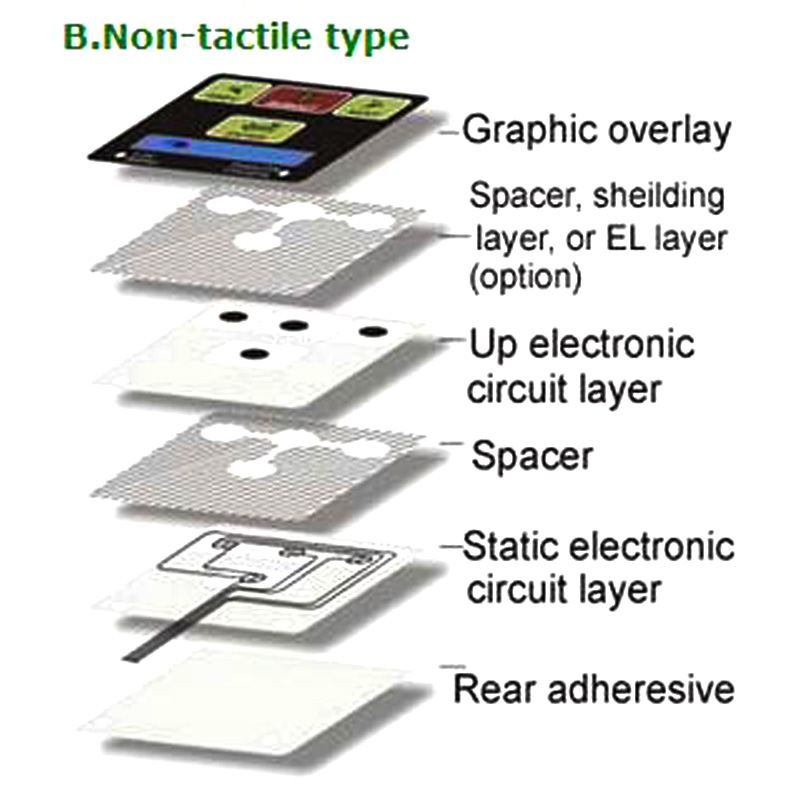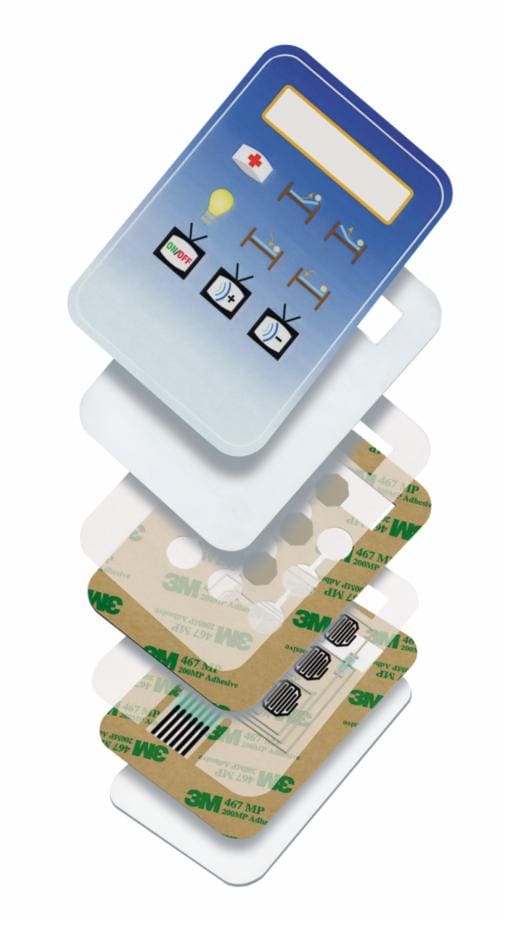The Production Process Behind Membrane Switch: What You Required to Know
The production procedure behind membrane layer switches over combines cautious style, product choice, and quality assurance. It starts with understanding the ins and outs of membrane layer switch layout and advances through different stages, consisting of product options and printing strategies. Each phase plays a vital duty in making sure functionality and toughness. The intricacies of layer construction and the extensive screening standards may expose understandings that are not quickly noticeable. What lies beyond these fundamental components?
Understanding Membrane Switch Over Design
Membrane buttons might show up straightforward at first glance, their design includes complex factors to consider that assure capability and durability. The design process begins with a complete understanding of customer needs, consisting of the user interface's desired application and ecological variables. Ergonomics is a key element, as the layout must facilitate ease of use while ensuring that responsive responses fulfills customer expectations.Moreover, the layering of parts, such as visuals overlays, sticky layers, and conductive traces, should be exactly engineered. membrane switch. This layered arrangement not just affects the switch's responsiveness but also influences its long life. Focus is provided to the sealing techniques employed to shield versus dampness and dirt, which might compromise performance. Additionally, layout factors to consider expand to appearances, where color pattern and aesthetic clearness enhance customer experience. Inevitably, the style of membrane switches over balances functionality, customer experience, and toughness, making sure that they meet the needs of different applications efficiently
Products Utilized in Membrane Switch Over Manufacturing
When picking materials for membrane layer switch manufacturing, it is important to ponder both performance and resilience. The key materials consist of polyester and polycarbonate films, which give versatility and toughness. These films are often coated with glue to ensure correct bonding to substrates. Conductive inks, commonly composed of silver or carbon, are essential for producing electric connections within the switch, permitting trusted operation.Additionally, a protective layer, such as a difficult layer, is often used to enhance scratch resistance and long life. The choice of backing material, such as acrylic or foam, can substantially impact the switch's responsive feeling and overall individual experience. Moreover, various ecological variables, including temperature and moisture, need to direct product option to assure peak performance in certain applications. Eventually, the ideal mix of products adds to the membrane layer button's functionality and lifespan, making notified options necessary for suppliers.
The Printing Refine: Creating Video and Text
The printing procedure in membrane layer button production plays a significant role in producing top quality graphics and text. Various graphic design techniques are employed to assure aesthetic allure and capability, while mindful ink option approaches are crucial for durability and efficiency. Recognizing these components is basic for attaining ideal outcomes in membrane layer switch design.
Graphic Style Techniques
Graphic design strategies play a crucial function in the printing process of membrane layer buttons, as they define just how graphics and message will ultimately show up on the end product. Reliable graphic layout includes the tactical use designs, shades, and font styles to improve readability and visual charm. Designers commonly utilize vector graphics for scalability, making certain that pictures continue to be sharp at different dimensions. Additionally, focus to contrast and positioning is vital, as it affects customer interaction and visual quality. The consolidation of branding components, such as logos, must be managed with like preserve brand name integrity. In general, thoughtful visuals design methods add considerably to the performance and good looks of membrane switches, affecting customer experience and product performance.
Ink Choice Approaches
Selecting the suitable ink is necessary for achieving the desired visual top quality and durability in membrane switch manufacturing. Numerous ink kinds are made use of, including solvent-based, water-based, and UV-curable inks. Each type provides unique features, such as adhesion, flexibility, and resistance to environmental factors. Solvent-based inks are typically favored for their sturdiness and lively shades, while water-based inks are a lot more eco-friendly however might have restrictions in bond. UV-curable inks supply fast treating and robust performance. Additionally, color matching strategies assure that the picked inks straighten with style specs. Eventually, the choice of ink must consider factors such as application approach, substratum compatibility, and end-use demands to accomplish exceptional lead to membrane layer switch graphics and text.
Layer Construction and Setting Up

Product Option Process
A careful selection of materials is necessary in the production procedure of membrane layer buttons, as it straight affects capability and resilience. The primary materials used include polyester, polycarbonate, and different conductive inks. Polyester is typically preferred for its exceptional resistance to chemicals and abrasion, making it appropriate for rough settings. Polycarbonate, on the various other hand, gives premium quality and impact resistance, which is advantageous for applications needing presence and effectiveness. Conductive inks, typically composed of silver or carbon, are vital for developing reputable electrical pathways. Furthermore, the selection of glue products affects the overall integrity of the button - membrane switch. Reviewing variables such as ecological exposure, tactile responses, and visual demands guides manufacturers in picking the most effective products for their particular applications
Layer Adhesion Strategies
Sticking layers in membrane button building and construction is a learn the facts here now crucial process that guarantees capability and durability. Various attachment methods are employed to safeguard optimal bonding between layers, which typically consist of using adhesives, warmth, and stress. Pressure-sensitive adhesives (PSAs) are commonly made use of for their simplicity of application and immediate bonding abilities. Additionally, thermal bonding methods can be used, where heat is you could try here utilized to activate glue residential properties, securing a solid bond. The choice of attachment method mainly depends on the products involved and the certain application needs of the membrane button. Proper placement and uniform application of adhesives are vital to prevent flaws, securing the switch runs effectively throughout its designated life-span.
Quality Assurance Procedures
Assuring high quality control throughout the layer building and construction and assembly of membrane layer buttons is essential for preserving efficiency and reliability. This process normally entails several vital actions, including extensive examinations at each phase of production. Producers use sophisticated screening approaches, such as peel tests and adhesion evaluations, to confirm the stability of layer bonds. In addition, aesthetic inspections are conducted to identify any problems in printing or material variances. Ecological problems, such as temperature level and moisture, are very carefully checked to assure ideal curing and adhesion. Regular calibration of equipment helps maintain precise production criteria. By applying these top quality control actions, suppliers can substantially reduce the threat of item failing, ensuring that the final membrane switches over fulfill the called for specs and client expectations.
Evaluating and Quality Assurance Measures

Technologies in Membrane Switch Over Innovation
As developments in modern technology proceed to advance, membrane buttons are gaining from innovative advancements that boost their functionality and individual experience. One significant innovation is the combination of capacitive touch technology, which permits more responsive and user-friendly interface. This change not only enhances looks yet likewise lowers mechanical deterioration, extending the life expectancy of the switches.Additionally, innovations in visuals overlay products have brought about enhanced resilience and resistance to environmental aspects such as wetness and UV light. These materials now supply improved clarity and illumination, more raising the aesthetic appeal.Furthermore, the incorporation of smart innovation is transforming membrane switches right into interactive control board, making it possible for connectivity with IoT tools. This connectivity promotes a smooth individual experience, leading the means for applications in different sectors, from health care to customer electronic devices. Jointly, these advancements position membrane layer changes as vital parts in modern device style.
Regularly Asked Inquiries
The length of time Does the Membrane Layer Switch Over Manufacturing Process Take?
The period of the membrane button manufacturing procedure can differ substantially. Variables such as intricacy, materials used, and production volume impact timelines, with common manufacturing varying from a few days to numerous weeks for conclusion.
What Are the Typical Applications for Membrane Buttons?
Membrane switches are typically utilized in various sectors, including auto controls, house home appliances, medical gadgets, and consumer electronic devices (membrane switch). Their flexibility and longevity make them perfect for applications calling for user-friendly interfaces and reputable efficiency in varied environments
Can Membrane Switches Over Be Personalized for Particular Demands?

What Is the Lifespan of a Common Membrane Switch Over?
The lifespan of a common membrane switch varies, however typically, it ranges from 1 to 5 million cycles. Aspects such as use, setting, and material quality significantly affect longevity and total efficiency gradually.

Are Membrane Layer Switches Over Eco-friendly?
The ecological friendliness of membrane switches differs. Some products used might not be recyclable, while others can be eco-friendly. The total influence depends upon manufacturing techniques and products, necessitating cautious factor to consider during option and disposal. The production process behind membrane switches combines careful layout, product choice, and top quality control. It starts with understanding the complexities of membrane layer switch style and advances through numerous phases, consisting of material options and printing methods. When selecting materials for membrane layer switch manufacturing, it is important to consider both performance and longevity. A mindful choice of products is crucial in the production process of membrane layer switches, as it straight influences capability and resilience. The selection of adhesion approach mainly depends on the materials included and the details application requirements of the membrane layer switch.
Comments on “Why membrane switch is key to innovation in aerospace control systems”